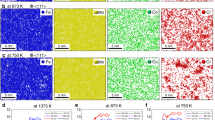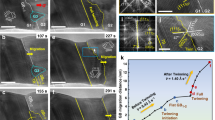Abstract
Ni–Ti is one of the most popular shape-memory alloys, a phenomenon resulting from a martensitic transformation. Commercial Ni–Ti-based alloys are often thermally treated to contain Ni4Ti3 precipitates. The presence of these precipitates can introduce an extra transformation step related to the so-called R-phase. It is believed that the strain field surrounding the precipitates, caused by the matrix–precipitate lattice mismatch, lies at the origin of this intermediate transformation step. Atomic-resolution transmission electron microscopy in combination with geometrical phase analysis is used to measure the elastic strain field surrounding these precipitates. By combining measurements from two different crystallographic directions, the three-dimensional strain matrix is determined from two-dimensional measurements. Comparison of the measured strain matrix to the eigenstrain of the R-phase shows that both are very similar and that the introduction of the R-phase might indeed compensate the elastic strain introduced by the precipitate.
This is a preview of subscription content, access via your institution
Access options
Subscribe to this journal
Receive 12 print issues and online access
$259.00 per year
only $21.58 per issue
Buy this article
- Purchase on Springer Link
- Instant access to full article PDF
Prices may be subject to local taxes which are calculated during checkout

 zone orientation.
zone orientation.
 orientation.
orientation.
Similar content being viewed by others
References
Lee, M. L., Fitzgerald, E. A., Bulsara, M. T., Currie, M. T. & Lochtefeld, A. J. Strained Si, SiGe, and Ge channels for high-mobility metal-oxide-semiconductor field-effect transistors. Appl. Phys. 97, 011101 (2005).
Antoniadis, D. A. et al. Continuous MOSFET performance increase with device scaling: The role of strain and channel material innovations. IBM J. Res. Dev. 50, 363–376 (2006).
Zhang, P. et al. Direct strain measurement in a 65 nm node strained silicon transistor by convergent-beam electron diffraction. Appl. Phys. 89, 161907 (2006).
Zschech, E., Whelan, C. & Mikolajick, T. Materials for Information Technology 99–108 (Springer, 2005).
Hÿtch, M. J., Snoeck, E. & Kilaas, R. Quantitative measurement of displacement and strain fields from HRTEM micrographs. Ultramicroscopy 57, 131–146 (1998).
Rouvière, J. L. & Sarigiannidou, E. Theoretical discussions on the geometrical phase analysis. Ultramicroscopy 106, 1–17 (2005).
Hÿtch, M. J., Putaux, J. L. & Penisson, J. M. Measurement of the displacement field of dislocations to 0.03 angstrom by electron microscopy. Nature 423, 270–273 (2003).
Johnson, C. L. et al. Effects of elastic anisotropy on strain distributions in decahedral gold nanoparticles. Nature Mater. 7, 120–124 (2008).
Hue, F., Hytch, M., Bender, H., Houdellier, F. & Claverie, A. Direct mapping of strain in a strained silicon transistor by high-resolution electron microscopy. Phys. Rev. Lett. 100, 156602 (2008).
Christiansen, S., Albrecht, M., Strunk, H. P. & Maier, H. J. Strained state of Ge(Si) islands on Si: Finite element calculations and comparison to convergent beam electron-diffraction measurements. Appl. Phys. Lett. 64, 3617–3618 (1994).
Khalil-Allafi, J., Dlouhy, A. & Eggeler, G. Ni4Ti3-precipitation during ageing of NiTi shape memory alloys and its influence on martensitic phase transformations. Acta Mater. 50, 4255–4274 (2002).
Nishida, M., Wayman, C. M. & Honma, T. Precipitation processes in near equiatomic TiNi shape memory alloys. Metall. Trans. A 17A, 1505–1515 (1986).
Tadaki, T., Nakata, Y., Shimizu, K. & Otsuka, K. Crystal structure, composition and morphology of a precipitate in an aged Ti-51 at%Ni shape memory alloy. Trans. Japan Inst. Met. 27, 731–740 (1986).
Tirry, W., Schryvers, D., Jorissen, K. & Lamoen, D. Electron diffraction structure refinement of Ni4Ti3 precipitates in Ni52Ti48 . Acta Crystallogr. B 62, 966–971 (2006).
Bataillard, L., Bidaux, J.-E. & Gotthardt, R. Interaction between microstructure and multiple-step transformation in binary NiTi alloys using in situ transmission electron microscopy observations. Phil. Mag. A 78, 327–344 (1998).
Carroll, M. C., Somsen, Ch. & Eggeler, G. Multiple-step martensitic transformations in Ni-rich NiTi shape memory alloys. Scr. Mater. 50, 187–192 (2004).
Fan, G. et al. Origin of abnormal multi-stage martensitic transformation behaviour in aged Ni-rich Ti–Ni shape memory alloys. Acta Mater. 52, 4351–4362 (2004).
Michutta, J., Somsen, Ch., Yawny, A., Dlouhy, A. & Eggeler, G. Elementary martensitic transformation processes in Ni-rich NiTi single crystals with Ni4Ti3 precipitates. Acta Mater. 54, 3525–3542 (2006).
Morawiec, H., Ilczuk, J., Stróż, D., Goryczka, T. & Chrobak, D. Two stage martensitic transformation in NiTi alloys caused by stress fields. J. de Phys. IV France 7, 155–159 (1997).
Dlouhy, A., Khalil-Allafi, J. & Eggeler, G. Multiple-step martensitic transformations in Ni-rich NiTi alloys–an in situ transmission electron microscopy investigation. Phil. Mag. A 3, 339–364 (2003).
Stróż, D. Proc. EMC 2004: 13th European Microscopy Congress Vol. CD (Belgium Society for Microscopy, 2004).
Tirry, W. & Schryvers, D. Quantitative determination of strain fields around Ni4Ti3 precipitates in NiTi. Acta Mater. 53, 1041–1049 (2005).
Van Dyck, D., Van Tendeloo, G. & Amelinckx, S. Direct interpretation of high resolution electron images of substitutional alloy systems with a column structure. Ultramicroscopy 10, 263–280 (1982).
Gall, K., Sehitoglu, H., Chumlyakov, Y. I., Kireeva, I. V. & Maier, H. J. The influence of ageing on critical transformation stress levels and martensite start temperatures in NiTi: Part I—aged microstructure and micro-mechanical modelling. J. Eng. Mater. Tech. 121, 19–27 (1999).
Khalil-Allafi, J. et al. The influence of temperature on lattice parameters of coexisting phases in NiTi shape memory alloys—a neutron diffraction study. Mater. Sci. Eng. A 378, 161–164 (2004).
Bhattacharya, K. Microstructure of Martensite, Why it Forms and How it Gives Rise to the Shape-Memory Effect (Oxford Univ. Press, 2003).
Van Aert, S., den Dekker, A. J., Van Dyck, D. & van den Bos, A. High-resolution electron microscopy and electron tomography: Resolution versus precision. J. Struct. Biol. 138, 21–33 (2002).
Yang, Z., Tirry, W., Lamoen, D., Kulkova, S. & Schryvers, D. Electron energy-loss spectroscopy and first-principles calculation studies on a Ni–Ti shape memory alloy. Acta Mater. 56, 395–404 (2008).
Yang, Z., Tirry, W. & Schryvers, D. Analytical TEM investigations on concentration gradients surrounding Ni4Ti3 precipitates in Ni–Ti shape memory material. Scr. Mater. 52, 1129–1134 (2005).
Šittner, P., Landa, M., Lukáš, P. & Novák, V. R-phase transformation phenomena in thermomechanically loaded NiTi polycrystals. Mech. Mater. 38, 475–492 (2006).
Acknowledgements
This work was supported by a Belspo project entitled ‘Physics based multilevel mechanics of metals‘ under the IAP framework, contract number P6-24. D. Schryvers would like to thank MULTIMAT ‘Multi-scale modelling and characterization for phase transformations in advanced materials’, a Marie Curie Research Training Network (MRTN-CT-2004-505226) for supporting this work.
Author information
Authors and Affiliations
Contributions
W.T. carried out the microscopy, analysed the images, evaluated the obtained results and wrote the paper, D.S. provided the project planning, contributed to the evaluation, discussed the data and commented on the paper.
Corresponding author
Supplementary information
Supplementary Information
Supplementary Information (PDF 283 kb)
Rights and permissions
About this article
Cite this article
Tirry, W., Schryvers, D. Linking a completely three-dimensional nanostrain to a structural transformation eigenstrain. Nature Mater 8, 752–757 (2009). https://doi.org/10.1038/nmat2488
Received:
Accepted:
Published:
Issue Date:
DOI: https://doi.org/10.1038/nmat2488
This article is cited by
-
The innate interfacial elastic strain field of a transformable B2 precipitate embedded in an amorphous matrix
npj Computational Materials (2023)
-
Characterization of microstructure, grain distribution, and tribocorrosion properties of NiTi-based alloy
Journal of Materials Science (2022)
-
Enabling nanoscale flexoelectricity at extreme temperature by tuning cation diffusion
Nature Communications (2018)
-
Optimization of Automated Crystal Orientation Mapping in a TEM for Ni4Ti3 Precipitation in All-Round SMA
Shape Memory and Superelasticity (2016)
-
The peculiarity of the metal-ceramic interface
Scientific Reports (2015)



